#Component Speaker System
Explore tagged Tumblr posts
Text
Looking for the best car speakers that won't break the bank? Check out our list of the top 10 best car speakers on a budget and upgrade your ride today!
#Alpine S-S65C#audio system#best budget speakers for car#best budget speakers for music#Best Car Speakers#best car speakers on a budget#Car speakers#car stereo#Coaxial Speaker#Component Speaker System#Hertz HCX 165#high-quality sound#Infinity Kappa 62IX#Jbl Gto609c#JL Audio C2-650X#Kenwood KFC-6966S#Kicker 43DSC504#new car speakers#Pioneer TS-A1670F#Polk Audio DB651#Rockford Fosgate r165x3#top 10 best car speakers
0 notes
Text
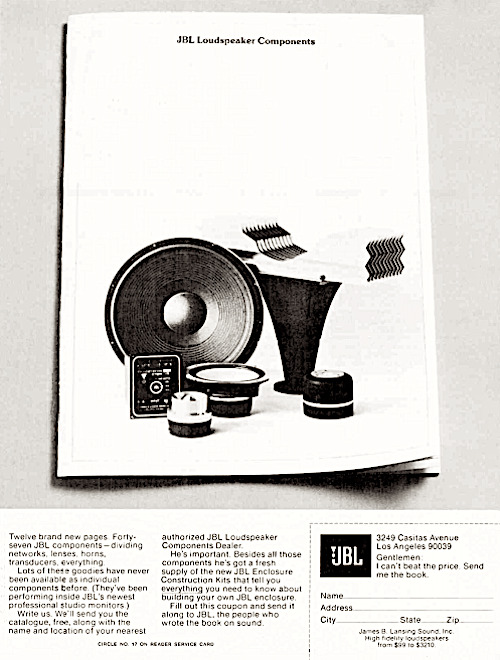
From the classic audio files: JBL ad promoting their new for 1975 JBL Loudspeaker Components brochure.
#vintage advertising#jbl#jbl loudspeakers#jbl monitors#jbl studio monitors#studio monitors#jbl speakers#vintage hifi#vintage audio#stereo speakers#stereo equipment#vintage stereo#james b. lansing#sound systems#vintage electronics#stereo components#jbl speaker components#jbl loudspeaker components#loudspeaker components#stereo systems#speaker components
3 notes
·
View notes
Text
#headphones#home audio system#speaker placement#subwoofer setup#audio wiring#home theater#sound optimization#audio components#audio calibration#home entertainment#audio setup guide
0 notes
Text
Upgrade Your Toyota Innova Sound Experience: Key Features to Consider
When you own a Toyota Innova Crysta, you expect comfort, reliability, and a smooth driving experience. But one aspect that can truly elevate your time on the road is a great music system. Whether you're taking a long road trip or just commuting through the city, having a high-quality sound system can make all the difference.
In this blog, we'll walk you through key features to consider when upgrading your Innova Crysta music system. You'll discover what elements contribute to great sound quality and why making the right choices will greatly enhance your driving experience.
1. Sound Quality: The Heart of Your Music System
When choosing a music system for your Innova Crysta, the first and most important feature to focus on is sound quality. A top-notch music system will offer crystal-clear sound, deep bass, and vibrant treble. You want a system that delivers high-quality audio whether you're listening to your favorite songs, podcasts, or the latest audiobook.
When exploring options for your Innova Crysta music system, pay attention to the speaker quality. Check for systems with a good frequency response, which means they can handle both low and high sounds effectively. You'll also want to look for systems with minimal distortion at high volumes, ensuring the sound stays clean and clear no matter how loud you turn up the music.
2. Speaker Configuration: Coaxial vs. Component
There are two main types of speaker systems you can choose from: coaxial and component. Coaxial speakers are commonly found in many cars, and they combine the woofer and tweeter in one speaker. They're a good choice for basic sound, but they may not give you the richness or clarity of more advanced systems.
Component speakers, on the other hand, separate the woofer, tweeter, and other elements. This allows for better sound positioning and a clearer, more dynamic sound experience. For those looking to truly enhance their Innova Crysta music system, component speakers are definitely worth considering for a more immersive audio experience.
3. Amplifiers: Power Up Your Music
An amplifier is an essential part of any high-quality music system. It boosts the audio signal, ensuring that your speakers receive enough power to deliver crisp, detailed sound. While many stock sound systems in cars come with basic amplifiers, upgrading to a more powerful one can dramatically improve your audio experience.
When upgrading your Innova Crysta music system, consider investing in an amplifier with enough power to drive all your speakers effectively. This ensures that you'll get clear, balanced sound throughout your car, no matter where you or your passengers are seated.
4. Subwoofers: Feel the Bass
A subwoofer can take your music experience to the next level, especially if you enjoy bass-heavy genres like hip hop, EDM, or rock. The subwoofer handles low-frequency sounds, delivering that deep, thumping bass that makes your music feel more immersive.
When upgrading your Innova Crysta music system, consider adding a subwoofer to balance out the highs and lows in your music. With a good subwoofer, you'll not only hear the bass but feel it, transforming your car into a concert on wheels.
5. User-Friendly Interface: Keep It Simple
No one wants a music system that's difficult to use, especially while driving. A user-friendly interface is key when choosing a new Innova Crysta music system. Look for systems with intuitive controls, easy-to-read displays, and compatibility with your smartphone. Bluetooth connectivity, USB ports, and hands-free calling are all features that make your driving experience more convenient and enjoyable.
6. Customization Options: Tailor Your Sound
Not all drivers want the same sound experience. Some prefer extra bass, while others focus on clarity. A high-quality Innova Crysta music system should give you the ability to customize your sound settings. Look for systems with equalizers that allow you to adjust the bass, treble, and midrange according to your preferences.
Additionally, some systems offer preset sound profiles for different genres of music, making it easy to switch between settings depending on what you're listening to.
Conclusion:
Upgrading your Innova Crysta music system is an investment that can significantly improve your driving experience. By focusing on key features like sound quality, speaker configuration, amplifiers, subwoofers, and ease of use, you can turn your car into a sound sanctuary. Whether you're an audiophile or just someone who enjoys listening to music on the go, a great music system will make every trip more enjoyable. Ready to upgrade your Innova Crysta music system? Explore top-quality options that deliver exceptional sound, easy functionality, and customizable features. Don't settle for standard—enhance your driving experience today!
#innova crysta music system#how long do car speakers last#how do you install a car stereo#coaxial speakers vs component speakers
0 notes
Text
How Can I Improve My Car's Audio System?
How Can I Improve My Car’s Audio System? Improving your car’s audio system can transform your driving experience, turning mundane commutes into enjoyable journeys filled with high-quality sound. Whether you’re a casual listener or an audiophile, there are several steps you can take to enhance your car’s audio setup. Key Statistics: 67% of car owners believe that an upgraded audio system…
#aftermarket speakers#amplifier setup#amplifiers#audio enhancement#audio equipment#audio settings#audio system#audio upgrade#automotive audio#bass#car accessories#car acoustics#car audio#car audio brands#car audio components#car audio gear#car audio guide#car audio installation#car audio maintenance#car audio tech#car audio tips#car electronics#car entertainment#car modification#car music#car sound#car sound system#car speakers#car stereo#car upgrades
0 notes
Text

My concepts for the development progress of an Iterators Puppet
-my ideas below
-Feasibility Study
[1]: First autonomous control module, any instruction to be given must be done manually through physical means (the keys), outputs were shown through the screen. A very primitive system, however, did its job proving the greater machine concept was achievable. While it does look like a lens above the monitor, this was a simple status gauge for benchmarking.
-Prototyping and Development
[2]: Now with the capability to wirelessly and audibly communicate to receive instructions and inputs. The system was no longer directly integrated into the facility, and resided on the first instance of an iterator's arm. This was considered a feat due to the complications with isolating the control module from the rest of the iterators components, while keeping processing power. A permanent connection/umbilical was needed to sustain life and function though.
To “talk” back, they were crafted with multidimensional projectors, the mobile arm allowing the angles and variance for this projection. Only later into development were advanced speakers installed for optimized understanding, however the extra computing power required to synthesize proper speech was found to strain the contained module, so this function had rare use in the end.
[3]: At this point there was a change in perspective in the project. What once were machines to simply compute and simulate, were now planned to be the home, caregiver, and providers. The further the project came to fruition the more religious importance was placed upon these “random gods”. From this stance not only did the puppets have to manage and control their facilities, they had to communicate with the people and priests. To represent benevolent beings who will bring their end and salvation. In this process iterators began to take a more humanoid shape, to better reflect their parents. Development was focused on compacting the puppet closer to the size of an ancient for this purpose. This stage was the first to incorporate a cloak/clothing into their design considerations, to further akin themselves in looks. The cloak would hide the iterators' engineered bodies and give a body to their silhouette.
[4]: As bioengineering and mechanics were rapidly progressing due to the void fluid revolution, this allowed plenty of margin for developing the outer design of the iterator puppets. This prototype was the first to incorporate limbs for the purpose of body language. This was another step in the drive to give a body to their random gods.
-Final Iterations
[5]: First generation iterators had the final redesign of puppet bodies. Far different from their first designs, they are fully humanoid. Their bodies are shaped to be organic and as full of life as they could at the time. Their center of sapience has fully settled within their body, as can be seen as their unconscious use of limbs without the direct intention for communication. This can also see how they manage their work, where many of the functions (which can be done with just an internal request) are operated through physical gestures of their limbs. Their puppet chambers also allow for full comprehensive projection, where many of their working monitors are displayed. It is seen how iterators prefer to utilize their traversal arm to transfer between the current working projection window.
These designs were hardy and nearly self-sufficient, only requiring minimal power from their umbilical to charge. (However was still limited in the terms of internal power production, for this first generation extensive batteries sufficed)
[6]: Later generation not only incorporated advanced bioengineering internally, but externally. While still a hardened shell, their body plates have been incorporated into the organics of the puppet, maintaining the protective requirements while barely leaving a trace of hinges or plates. This “soft” skin had drawbacks, such as reduced durability to the first generations, this was offset by the greatly enhanced repair speeds and capability this type of skin allowed.
Internal power generation was implemented into these late generation models. If the case arose, the Puppet could be disconnected from their umbilical and still be conscious from an undefined period of time. (However this would limit the operating capacity of the puppet when running self sufficiently) This greatly eased maintenance works, as the Puppet could still run the greater facility wirelessly while work was done on the chamber, arm or whatever as needed.
1K notes
·
View notes
Text
DIY Home Entertainment: How to Build Your Own Sound System on a Budget
In recent years, there has been a surge in the popularity of DIY home entertainment systems. As technology continues to advance, it has become easier and more cost-effective to build your own sound system at home. Not only does this give you the opportunity to customize your setup to your specific needs and preferences, but it also allows you to save money compared to purchasing a pre-made…

View On WordPress
#audio components#build#distortion#diy#equalization#frequency response#home entertainment#installation#media#optimization#phase response#placement#room acoustics#sharing experiences#sound system#speakers#tools#troubleshooting#wiring
1 note
·
View note
Text
How to have cancer

THIS WEEKEND (November 8-10), I'll be in TUCSON, AZ: I'm the GUEST OF HONOR at the TUSCON SCIENCE FICTION CONVENTION.

I've got cancer but it's probably (almost certainly, really) okay. Within a very short period I will no longer have cancer (at least for now). This is the best kind of cancer to have – the kind that is caught early and treated easily – but I've learned a few things on the way that I want to share with you.
Last spring, my wife put her arm around my waist and said, "Hey, what's this on your rib?" She's a lot more observant than I am, and honestly, when was the last time you palpated your back over your left floating rib? Sure enough, there was a lump there, a kind of squishy, fatty raised thing, half a centimeter wide and about four centimeters long.
I'm a 53 year old man with a family history of cancer. My father was diagnosed with lymphatic cancer at 55. So I called my doctor and asked for an appointment to have the lump checked over.
I'm signed up with Southern California Kaiser Permanente, which is as close as you come to the Canadian medicare system I grew up under and the NHS system I lived under for more than a decade. Broadly speaking, I really like KP. Its app – while terrible – isn't as terrible as the other apps, and they've taken very good care of me for both routine things like vaccinations and checkups, and serious stuff, like a double hip replacement.
Around the time of The Lump, I'd been assigned a new primary care physician – my old one retired – and so this was my first appointment with her. I used the KP app to book it, and I was offered appointments six weeks in the future. My new doc was busy! I booked the first slot.
This was my first mistake. I didn't need to wait to see my PCP to get my lump checked over. There was really only two things that my doc was gonna do, either prod it and say, "This is an extremely common whatchamacallit and you don't need to worry" or "You should go get this scanned by a radiologist." I didn't need a specific doctor to do this. I could have ridden my bike down to the KP-affiliated Urgent Care at our local Target store and gotten an immediate referral to radiology.
Six weeks go by, and my doc kind of rolls the weird lump between her fingers and says, "You'd better go see a radiologist." I called the Kaiser appointment line and booked it that day, and a couple weeks later I had a scan.
The next day, the app notified me that radiology report was available in my electronic heath record. It's mostly technical jargon ("Echogenic areas within mass suggest fatty component but atypical for a lipoma") but certain phrases leapt out at me: "malignant masses cannot be excluded. Follow up advised."
That I understood. I immediately left my doctor a note saying that I needed a biopsy referral and set back to wait. Two days went by. I left her a voice message. Another two days went by. I sent another email. Nothing, then a weekend, then more nothing.
I called Kaiser and asked to be switched to another Primary Care Physician. It was a totally painless and quick procedure and within an hour my new doc's intake staff had reviewed my chart, called me up, and referred me for a biopsy.
This was my second mistake. When my doctor didn't get back to me within a day, I should have called up KP and raised hell, demanding an immediate surgical referral.
What I did do was call Kaiser Member Services and file a grievance. I made it very clear that when I visited my doctor, I had been very happy with the care I received, but that she and her staff were clearly totally overloaded and needed some kind of administrative intervention so that their patients didn't end up in limbo.
This is a privilege. I'm a native English speaker, and although I was worried about a serious illness, I didn't have any serious symptoms. I had the ability and the stamina to force action in the system, and my doing so meant that other patients, not so well situated as I was, would not be stuck where I had been, with fewer resources to get un-stuck.
The surgeon who did the biopsy was great. He removed my mass. It was a gross lump of yellowy-red gunk in formaldehyde. He even let me photograph it before it went to pathology (warning, gross):
https://www.flickr.com/photos/doctorow/54038418981/
They told me that the pathology would take 2-5 days. I reloaded the "test results" tab in the KP website religiously after 48 hours. Nothing was updated. After five days, I called the surgical department (I had been given a direct number to reach them in case of postsurgical infections, and made a careful note of it).
It turned out that the pathology report had been in hand for three days at that point, but it was "preliminary" pending some DNA testing. Still, it was enough that the surgeon referred me to an oncologist.
This was my third mistake: I should have called after 48 hours and asked whether the pathology report was in hand, and if not, whether they could check with pathology. However, I did something very right this time: I got a phone number to reach the specialist directly, rather than going through the Kaiser main number.
My oncologist appointment was very reassuring. The oncologist explained the kind of cancer I had ("follicular lymphoma"), the initial prognosis (very positive, though it was weird that it manifested on my rib, so far from a lymph node) and what needed to happen next (a CT/PET scan). He also walked me through the best, worst and medium-cases for treatment, based on different scan outcomes. This was really good, as it helped me think through how I would manage upcoming events – book tours, a book deadline, work travel, our family Christmas vacation plans – based on these possibilities.
The oncologist gave me a number for Kaiser Nuclear Medicine. I called them from the parking lot before leaving the Kaiser hospital and left a message for the scheduler to call me back. Then I drove home.
This was my fourth mistake. The Kaiser hospital in LA is the main hub for Kaiser Southern California, and the Nuclear Medicine department was right there. I could have walked over and made an appointment in person.
Instead, I left messages daily for the next five days, waited a weekend, then called up my oncologist's staff and asked them to intervene. I also called Kaiser Member Services and filed an "urgent grievance" (just what it sounds like) and followed up by filing a complaint with the California Patient Advocate:
https://www.dmhc.ca.gov/
In both the complaint and the grievance, I made sure to note that the outgoing message at Nuclear Medicine scheduling was giving out false information (it said, "Sorry, all lines are busy," even at 2am!). Again, I was really careful to say that the action I was hoping for was both a prompt appointment for me (my oncologist had been very insistent upon this) but also that this was a very broken system that would be letting down every patient, not me, and it should be fixed.
Within a couple hours, I had a call back from KP grievances department, and an hour after that, I had an appointment for my scan. Unfortunately, that was three weeks away (so much for my oncologist's "immediate" order).
I had the scan last week, on Hallowe'en. It was really cool. The gadget was awesome, and the rad-techs were really experienced and glad to geek out with me about the way the scanner and the radioactive glucose they infused in me interacted. They even let me take pictures of the scan visualizations:
https://www.flickr.com/photos/doctorow/54108481109/
The radiology report was incredibly efficient. Within a matter of hours, I was poring over it. I had an appointment to see the doc on November 5, but I had been reading up on the scans and I was pretty sure the news was good ("No enlarged or FDG avid lymph nodes are noted within the neck, chest, abdomen, or pelvis. No findings of FDG avid splenic or bone marrow involvement").
There was just one area of concern: "Moderate FDG uptake associated with a round 1.3 cm left inguinal lymph node." The radiologist advised the oncologist to "consider correlation with tissue sampling."
Today was my oncology appointment. For entirely separate reasons, I was unable to travel to the hospital today: I wrenched my back over the weekend and yesterday morning, it was so bad that I couldn't even scratch my nose without triggering unbearable spams. After spending all day yesterday in the ER (after being lifted out of my house on a stretcher), getting MRIs and pain meds, I'm much better off, though still unable to get out of bed for more than a few minutes at a time.
So this morning at 8:30 sharp, I started calling the oncology department and appointment services to get that appointment changed over to a virtual visit. While I spent an hour trying various non-working phone numbers and unsuccessfully trying to get Kaiser appointment services to reach my oncologist, I tried to message him through the KP app. It turns out that because he is a visiting fellow and not staff, this wasn't possible.
I eventually got through to the oncology department and had the appointment switched over. The oncology nurse told me that they've been trying for months to get KP to fix the bug where fellows can't be messaged by patients. So as soon as I got off the phone with her, I called member services and filed another grievance. Why bother, if I'd gotten what I needed? Same logic as before: if you have the stamina and skills to demand a fix to a broken system, you have a duty to use them.
I got off the phone with my oncologist about an hour ago. It went fine. I'm going to get a needle biopsy on that one suss node. If it comes back positive, I'll get a few very local, very low-powered radiation therapy interventions, whose worst side effect will be "a mild sunburn over a very small area." If it's negative, we're done, but I'll get quarterly CT/PET scans to be on the safe side.
Before I got off the phone, I made sure to get the name of the department where the needle biopsy would be performed and a phone number. The order for the biopsy just posted to my health record, and now I'm redialing the department to book in that appointment (I'm not waiting around for them to call me).
While I redial, a few more lessons from my experience. First, who do you tell? I told my wife and my parents, because I didn't want to go through a multi-week period of serious anxiety all on my own. Here, too, I made a mistake: I neglected to ask them not to tell anyone else. The word spread a little before I put a lid on things. I wanted to keep the circle of people who knew this was going on small, until I knew what was what. There's no point in worrying other people, of course, and my own worry wasn't going to be helped by having to repeat, "Well, it looks pretty good, but we won't know until I've had a scan/my appointment/etc."
Next, how to manage the process: this is a complex, multi-stage process. It began with a physician appointment, then a radiologist, then a pathology report, then surgery, then another pathology report, then an oncologist, then a scan, then another radiologist, and finally, the oncologist again.
That's a lot of path-dependent, interdepartmental stuff, with a lot of ways that things can fall off the rails (when my dad had cancer at my age, there was a big gap in care when one hospital lost a fax from another hospital department and my folks assumed that if they hadn't heard back, everything was fine).
So I have been making extensive use of a suspense file, where I record what I'm waiting for, who is supposed to provide it, and when it is due. Though I had several places where my care continuity crumbled some, there would have been far more if I hadn't done this:
https://pluralistic.net/2024/10/26/one-weird-trick/#todo
The title of this piece is "how to have cancer," but what it really boils down to is, "things I learned from my own cancer." As I've noted, I'm playing this one on the easiest setting: I have no symptoms, I speak and write English fluently, I am computer literate and reasonably capable of parsing medical/technical jargon. I have excellent insurance.
If any of these advantages hadn't been there, things would have been a lot harder. I'd have needed these lessons even more.
To recap them:
See a frontline care worker as soon as possible: don't wait for an appointment with a specific MD. Practically any health worker can prod a lump and refer you for further testing;
Get a direct phone number for every specialist you are referred to (add this to your phone book); call them immediately after the referral to get scheduled (better yet, walk over to their offices and schedule the appointment in person);
Get a timeframe as to when your results are due and when you can expect to get a follow-up; call the direct number as soon as the due-date comes (use calendar reminders for this);
If you can't get a call back, an appointment, or a test result in a reasonable amount of time (use a suspense file to track this), lodge a formal complaint with your insurer/facility, and consider filing with the state regulator;
Think hard about who you're going to tell, and when, and talk over your own wishes about who they can tell, and when.
As you might imagine, I've spent some time talking to my parents today as these welcome results have come in. My mother is (mostly) retired now, and she's doing a lot of volunteer work on end-of-life care. She recommends a book called Hope for the Best, Plan for the Rest: 7 Keys for Navigating a Life-Changing Diagnosis:
https://pagetwo.com/book/hope-for-the-best-plan-for-the-rest/
I haven't read it, but it looks like it's got excellent advice, especially for people who lack the self-advocacy capabilities and circumstances I'm privileged with. According to my mom, who uses it in workshops, there's a lot of emphasis on the role that families and friends can play in helping someone whose physical, mental and/or emotional health are compromised.
So, that's it. I've got cancer. No cancer is good. This cancer is better than most. I am almost certainly fine. Every medical professional I've dealt with, and all the administrative support staff at Kaiser, have been excellent. Even the doc who dropped the ball on my biopsy was really good to deal with – she was just clearly drowning in work. The problems I had are with the system, not the people. I'm profoundly grateful to all of them for the help they gave me, the interest and compassion they showed, and the clarity and respect they demonstrated in my dealings with them.
I'm also very grateful to my wife, my parents, and my boss at EFF, all of whom got the news early and demonstrated patience, love, and support that helped in my own dark hours over the past couple of months.
I hope you're well. But you know, everyone gets something, eventually. When you find yourself mired in a broken system full of good people, work the system – for yourself and for the people who come behind you. Take records. Make calls.
Look after yourself.

If you'd like an essay-formatted version of this post to read or share, here's a link to it on pluralistic.net, my surveillance-free, ad-free, tracker-free blog:
https://pluralistic.net/2024/11/05/carcinoma-angels/#squeaky-nail
394 notes
·
View notes
Note
Now I'm wondering how countries like Japan and China teach literacy.
Since kanji / hanzi don't really have that much in the way of phonetic elements, they kinda have to teach them by memorization and I don't think they have many reading comprehension problems over there.
(Although both countries do have supplementary phonetic writing systems in the form of bopomofo and pinyin for China, and the kanas for Japan)
--
FAVORITE SOAPBOX TOPIC UNLOCKED!
RELEASE THE KRAKEN!
It's a little closer to teaching vocabulary than spelling, but the same kinds of principles apply: You teach the building blocks, like the traditional radicals, which aren't so different from teaching Latin and Greek roots in an English class for English speakers.
And, as a matter of fact, lots of those radicals do predict pronunciation, just not in every single case. They can also be clues to meaning, but again, not absolutely consistently. Many characters have a sound-cueing radical on one side and a meaning-cueing radical on the other. It's just that only some are still useful in the modern day, while others are more like the English word 'plumbing' where knowledge of Roman lead pipes explains why this word comes from the one for lead, but the root probably wouldn't help a kid learn the word in the first place.
One similarity to teaching phonics would be teaching students to tell very complicated and similar characters apart: you want to help a student spot all the little building blocks of the character and then spot the ones that are different, not just glance at the whole character and get a general overall vibe. If you do a whole look-based approach, too many characters are too easy to mistake for one another.
Remembering a bajillion Chinese characters is hard if you're trying to memorize them in a year and not all of elementary school, but I think people who don't read them underestimate how many component parts there are and how approachable they can be if you start by learning fundamentals, not just memorizing a few individual characters as though they have no relation to anything else.
They're actually pretty systematic, just in the way that English spelling is with its overlapping systems and historical artifacts, not in the way that highly regular Spanish spelling is.
Having taken a lot of Japanese classes, I will say that Japanese as a foreign language textbooks often do a piss poor job of this and totally do teach kanji in a sight words-y way... But my Mandarin class started with important foundational concepts that served me well in Japanese later even if I bombed out of Chinese class at the time.
Can you tell how irritated I am by all the foreign language learners who think characters are sooooo hard when, really, it's just their crappy textbook? Haha.
They're moderately hard in the way that learning a full adult spectrum of vocabulary is hard, but people do that for foreign languages all the time. The countries that use characters do tend to make sets that are smaller for certain kinds of applications, same as we have things like simple English wikipedia, but a literate adult will always know lots more, whether it's from their career in engineering or their predilection for historical romance novels.
Uh... anyway, the answer is "Bit by bit in elementary school, just like in any other country".
684 notes
·
View notes
Text
Fake-tanuki soup or Fake tanuki-soup?
連濁(れんだく; en: rendaku)is a phonological rule in japanese that makes the first voiceless consonant of a word change into a voiced consonant when used in a compound word. For example, おり + かみ → おりがみ (ori + kami → origami) ("fold" + "paper" → "paperfolding") - the /k/ sound in かみ becomes a /g/ sound (which is the voiced version of a /k/ sound) by adding a voicing mark -> が.
What’s interesting about 連濁 is that native speakers can use it subconsciously as a sort of “order of operations” system for unfamiliar words, like PEMDAS or BIDMAS in maths. A classic example of this is the にせたぬきじる problem[1]. Native speakers can immediately and with confidence tell the difference in meaning between two compound words they have never heard before, despite the only difference being the voicing of a single consonant. Take the three words 偽 (にせ, meaning “fake” or “imitation”), たぬき (tanuki, the Japanese racoon dog), and 汁 (しる, meaning “soup” or “broth”). They can be combined into the following compound words: にせたぬきじる and にせだぬきじる (note the voicing mark, or dakuten, on the latter). Keep in mind, these two words do not exist in ordinary japanese - they’ve been created as part of a linguistics experiment.
You might think the meaning would be ambiguous in those compound words: is it (imitation tanuki)+soup or imitation+(tanuki soup)? Let’s imagine we’re referring to the former. First, we combine にせ+たぬき. There’s a rule that rendaku can’t occur if there’s already a voicing mark in the second component of the compound, but we’re safe here - たぬき has no voicing mark. Therefore, it becomes にせだぬき. Then, we combine にせだぬき+しる. Again, しる has no voicing mark in it, so we’re safe to add it in, and we get にせだぬきじる.
Conversely, let’s say we were referring to fake “tanuki-soup”. First we combine たぬき+しる. This combines safely to たぬきじる. Then we combine にせ+たぬきじる. But wait, the second component does already have a voicing mark, on じ! So we can’t add one to た. Therefore we end up with にせたぬきじる.
That’s a lot of thinking and linguistic hoops to jump through to make up 2 words, but here’s the thing: Japanese native speakers who have never heard these words before can instinctively deduce the difference in meaning with startling accuracy. They correctly determine the meaning of にせだぬきじる as “a broth made from imitation tanuki” and にせたぬきじる as “a fake version of a dish called ‘tanuki soup’”. Even more surprising is the research findings of Shigeto Kawahara, which show that children as young as 9 years old can consistently deduce the difference as well[2]. I think this shows how incredibly powerful the subconscious mind is at learning linguistic rules, and how bad the conscious mind is at learning them!
#langblr#japanese#japanese language#language acquisition#language learning#language#linguistics#learning japanese#日本語#jimmy blogthong
719 notes
·
View notes
Note
Hey! I'm not sure you still do those, but I saw you giving advice to people in your inbox before and I'm kinda in the need of some. Do you have any tips on describing gesticulation/hand movement? Thank you in advance!
Writing Notes: Hand Movements
Kinesics - refers to body movements and posture
Includes the following components: gestures, head movements and posture, eye contact, and facial expressions.
Comes from the root word kinesis, which means “movement,” and refers to the study of hand, arm, body, and face movements.
Gestures - arm and hand movements; include adaptors like clicking a pen or scratching your face, emblems like a thumbs-up to say “OK,” and illustrators like bouncing your hand along with the rhythm of your speaking.
There are 3 main types of gestures: adaptors, emblems, and illustrators (Andersen, 1999).
Adaptors - touching behaviors and movements that indicate internal states typically related to arousal or anxiety. Adaptors can be targeted toward the self, objects, or others. In regular social situations, adaptors result from uneasiness, anxiety, or a general sense that we are not in control of our surroundings. Many of us subconsciously click pens, shake our legs, or engage in other adaptors during classes, meetings, or while waiting as a way to do something with our excess energy. Public speaking students who watch video recordings of their speeches notice nonverbal adaptors that they didn’t know they used. In public speaking situations, people most commonly use self- or object-focused adaptors. Common self-touching behaviors like scratching, twirling hair, or fidgeting with fingers or hands are considered self-adaptors. Some self-adaptors manifest internally, as coughs or throat-clearing sounds. My personal weakness is object adaptors. Specifically, I subconsciously gravitate toward metallic objects like paper clips or staples holding my notes together and catch myself bending them or fidgeting with them while I’m speaking. Other people play with dry-erase markers, their note cards, the change in their pockets, or the lectern while speaking. Use of object adaptors can also signal boredom as people play with the straw in their drink or peel the label off a bottle of beer. Smartphones have become common object adaptors, as people can fiddle with their phones to help ease anxiety. Finally, as noted, other adaptors are more common in social situations than in public speaking situations given the speaker’s distance from audience members. Other adaptors involve adjusting or grooming others, similar to how primates like chimpanzees pick things off each other. It would definitely be strange for a speaker to approach an audience member and pick lint off his or her sweater, fix a crooked tie, tuck a tag in, or pat down a flyaway hair in the middle of a speech.
Emblems - are gestures that have a specific agreed-on meaning. These are still different from the signs used by hearing-impaired people or others who communicate using American Sign Language (ASL). Even though they have a generally agreed-on meaning, they are not part of a formal sign system like ASL that is explicitly taught to a group of people. A hitchhiker’s raised thumb, the “OK” sign with thumb and index finger connected in a circle with the other three fingers sticking up, and the raised middle finger are all examples of emblems that have an agreed-on meaning or meanings with a culture. Emblems can be still or in motion; for example, circling the index finger around at the side of your head says “He or she is crazy,” or rolling your hands over and over in front of you says “Move on.” Just as we can trace the history of a word, or its etymology, we can also trace some nonverbal signals, especially emblems, to their origins. Holding up the index and middle fingers in a “V” shape with the palm facing in is an insult gesture in Britain that basically means “up yours.” This gesture dates back centuries to the period in which the primary weapon of war was the bow and arrow. When archers were captured, their enemies would often cut off these two fingers, which was seen as the ultimate insult and worse than being executed since the archer could no longer shoot his bow and arrow. So holding up the two fingers was a provoking gesture used by archers to show their enemies that they still had their shooting fingers (Pease & Pease, 2004).
Illustrators - are the most common type of gesture and are used to illustrate the verbal message they accompany. For example, you might use hand gestures to indicate the size or shape of an object. Unlike emblems, illustrators do not typically have meaning on their own and are used more subconsciously than emblems. These largely involuntary and seemingly natural gestures flow from us as we speak but vary in terms of intensity and frequency based on context. Although we are never explicitly taught how to use illustrative gestures, we do it automatically. Think about how you still gesture when having an animated conversation on the phone even though the other person can’t see you.
Haptics - refers to touch behaviors that convey meaning during interactions. Touch operates at many levels, including functional-professional, social-polite, friendship-warmth, and love-intimacy.
We all make spontaneous hand movements, called gestures, when we talk. There are several different types of gestures that serve different purposes:
Co-Speech Gestures - Gestures that we produce spontaneously while talking.
Iconic Gestures - Hand movements that create pictures to describe objects or actions.
Beat Gestures - Repeated hand movements that follow the rhythm of speech.
Deictic Gestures - Gestures that direct the listener’s attention, such as pointing.
Examples of Gestures around the World
Argentina: “Be careful” - If you want to tell someone to be careful or watch out for their surroundings, just put your index finger below your eye and gently pull down.
Brazil: “It’s just gossip” - If you hear someone spreading stories that aren’t true, you can tap the underside of your jaw with the back of your hand. This signifies that what they’re saying is just gossip.
China: “Thank you” - Rest the palm of one hand on the fist of your other hand and give a slight bow.
France: “It’s easy” - You’re talking to someone from France, complaining about a difficult task. If they disagree with you, they might hold up two fingers toward their nostrils, meaning “It’s as easy as this!”
Germany: “Good luck” - If you’d like to wish someone luck in Germany, don’t cross your fingers. Instead, you need to press your thumbs (enclose them in your fists).
India: “Warm regards” - In India, you might see someone pressing their palms together as they greet you. It’s a sign of acceptance, warm regards and respect.
Korea: “I love/appreciate you” - A popular hand gesture in Korea to express love or appreciation is the finger heart, made by putting your thumb and index finger together in a kind of “x” that looks like a heart.
Mexico: “A lot” - To convey that there’s a lot of something, join all five fingers together and then shake your hand. You can use one hand or both hands for this one.
Poland: “That will never happen” - If someone tells you something you don’t believe, try pointing to your palm with your index finger. This means “A cactus would sooner grow on my hand”—in other words, “That will never happen.”
Spain: “Do you get it?” - If a Spanish person wants to check that you understand something they said (a joke, for instance), they might hold out their finger and thumb, as though they’re holding a very small item, and make a gentle twisting motion.
Sources: 1 2 3 ⚜ More: Writing Notes & References ⚜ Writing Resources PDFs
Hope this helps with your writing! (Yup, still do these. Usually in one sitting whenever I find free time, then they all get queued.)
#hand movements#gestures#writing notes#writeblr#dark academia#writing reference#writers on tumblr#literature#spilled ink#writing prompt#creative writing#light academia#writing tips#writing advice#fiction#writing resources
120 notes
·
View notes
Text

Dragon Age™: The Veilguard - Accessibility Resources - (Accessibility Portal information)
"In Dragon Age: The Veilguard, players are encouraged to be who they want to be and play how they want to play. This manifests in all sorts of ways, from our character classes to the dialogue choices. But delivering on this promise requires more than providing a variety of gameplay options; it also requires us to break down any barriers our players may be experiencing. For that reason, we incorporated accessibility considerations into our design documentation from very early in the game’s development, making the thoughtful and deliberate implementation of accessibility a foundational component of The Veilguard’s design. On first launch, players are provided a curated list of settings for UI text size options, subtitle options, controller options, and various display options. Upon starting a new game, players can use our Customizable Difficulty system to choose the level of challenge they want to experience. By selecting from a list of modular combat presets, they’ll be able to individually adjust a number of granular factors, including enemy aggression, enemy resistances, and combat timing. Similarly, our exploration presets allow players to modify on-screen guidance, such as markings that assist with way-finding and the distance at which interactable objects become highlighted. While we’re particularly proud of and excited about Customizable Difficulty, we encourage players to browse through all the settings and review the accessible design considerations outlined in this guide. And as always, accessibility is a continuous journey and we are actively listening to feedback from the community. Thank you."
"Noteworthy Features - Visual - Audio - Controls - Gameplay"
(The rest of this post is under a cut due to length.)
"VISUAL Subtitles - Subtitles can be set to Never, Conversations Only (excludes ambient NPC dialogue), or Always (all audible dialogue). By design, captions are embedded into subtitles to convey non-verbal sounds that progress the story or add additional context to some story beats and spoken words. - Advanced Subtitles Options are available, where size can be adjusted between three options, speaker names can be turned On/Off, background opacity can be scaled from 0% to 100%, and name colors can be adjusted for Rook and NPCs."

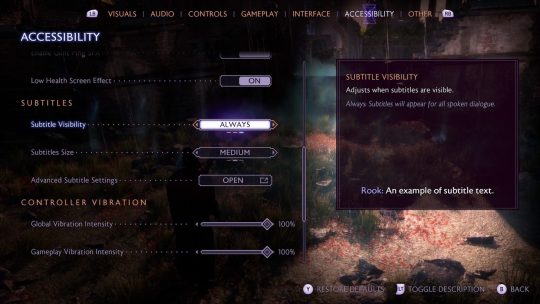
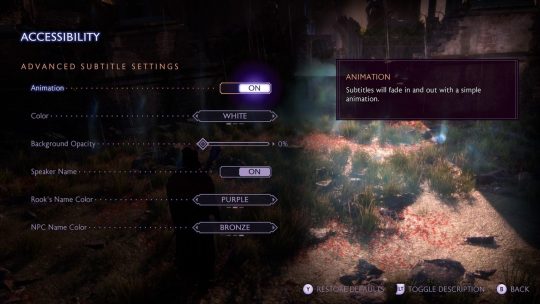
"User Interface - UI Text has two size options and uses a simple font. - Full-screen Colorblind filters are available for Protanopia, Deuteranopia, and Tritanopia. - Persistent Dot is available to display a small dot at the center of the screen. - Hiding HUD Elements is available for the Objective Tracker, Mini Map, Combat Text, Advanced Combat Text, Player Health, and Abilities."
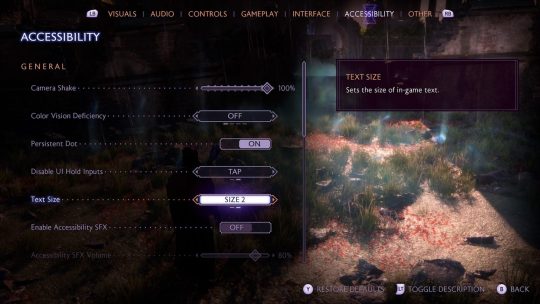
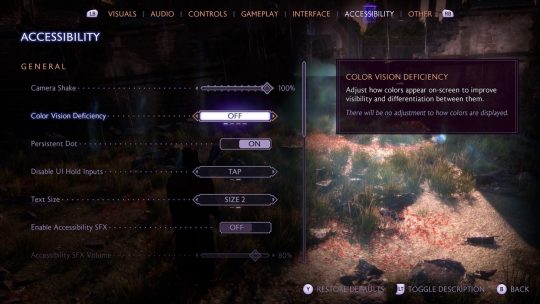
"Visual Design & Assists - Melee Threat Indicator provides a halo around the player character’s head to warn of incoming melee attacks. - Ranged Threat Indicator provides a visual line to show the direction of incoming ranged attacks. - Visual cues are present during combat and exploration, where no game-critical information needed to progress is conveyed through sound alone. See Customizable Exploration Presets for more."
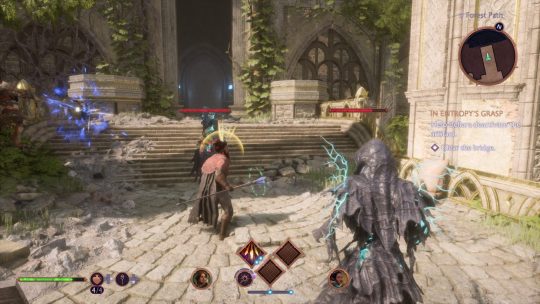
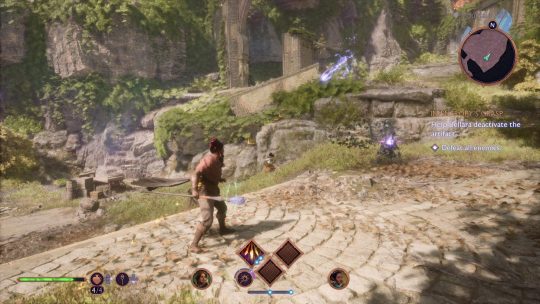
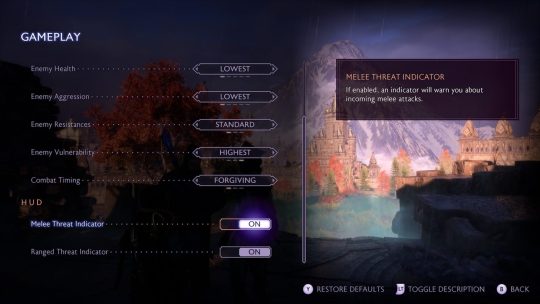
"Visual Effects - Motion Blur can be turned On/Off. - Camera Shake can be set between 0 (Off) and 100 (Max). Does not extend to cinematics. - Depth of Field can be set to On for cinematics only, On for gameplay only, On for both, or Off. Being On causes some elements of the scene to be in focus, and others to be out of focus. - Vignette can be turned On/Off. Being On creates a subtle darkening of the image towards the edge of the screen during cinematic and gameplay to enhance the atmosphere of scenes. - Low Health Screen Effect can be turned On/Off. Being On creates a blurry, desaturated effect across the screen during gameplay to emphasize low health."
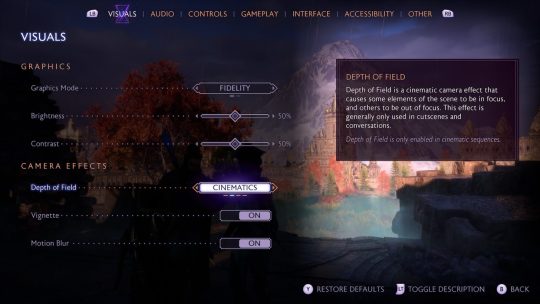
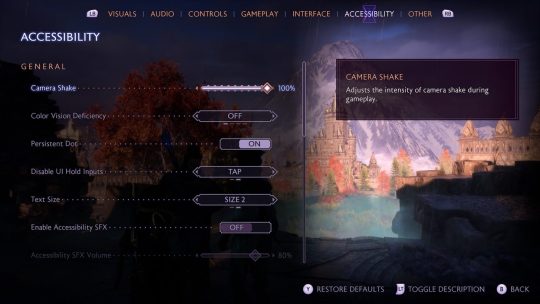
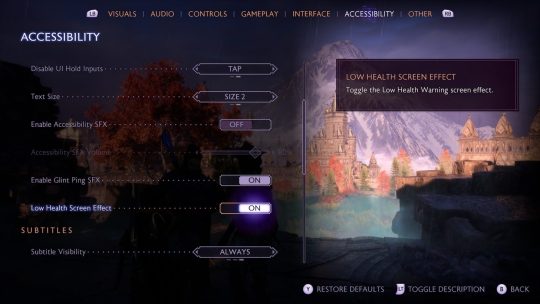
"AUDIO Audio Settings - Volume sliders for Global, Music, Speech, Sound Effects, Ambient, and Menu. - Speaker type for Wide Dynamic, Narrow Dynamic, Night Mode, and Headphones. - 3D Audio is available. Requires compatible hardware. - Mono Audio is available alongside a mono audio planning option between left and right outputs."
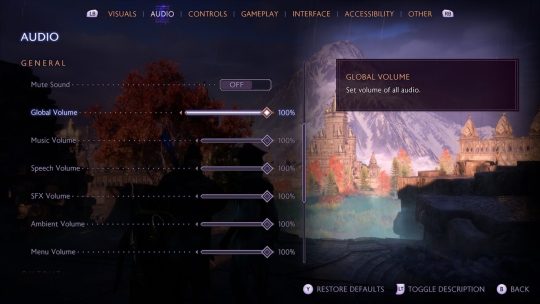
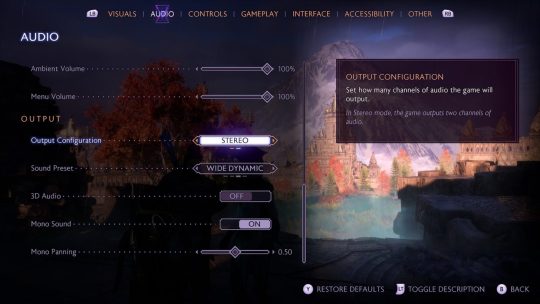
"Sound Design & Assists - Accessibility SFX is available and has a volume slider. Audio cues provide additional feedback for some visual mechanics. Includes an incoming attack indicator, target lock-on, and conversation wheels. - Glint Ping SFX is available where spatialized SFX will play at object locations when UP on the d-pad is pressed. Note: Depending on the Exploration Preset selected, players may need to adjust the Object Glint Visibility, and Object Marker Visibility settings to Pulse (Short), for this functionality to work."
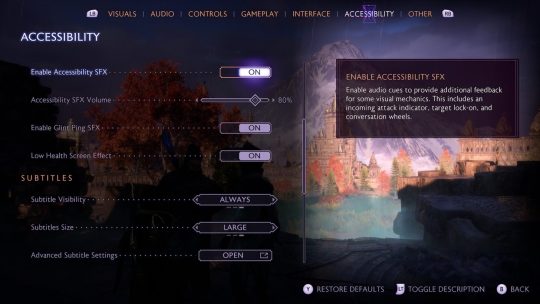
"CONTROLS Input Settings - Input Remapping for basic gameplay controls. Movement actions can only be remapped between analog sticks. - Invert Axis of X and Y can be individually adjusted for both controller and mouse. - Vertical and Horizontal Sensitivity sliders for both Cameras and Aiming. - Swap between Left and Right Sticks for Movement (left) and Look (right). - Stick Deadzones sliders for the Look and Movement sticks. - Trigger Deadzone slider for triggers on controllers. - Vibration Intensity slider for Global, Gameplay, Environment, and Cinematic."
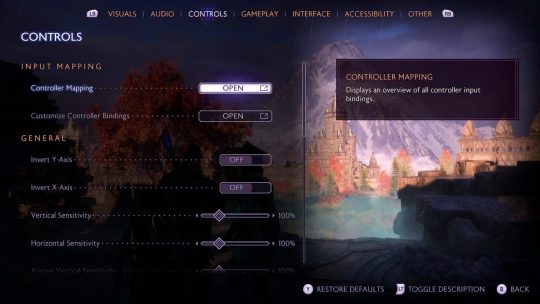
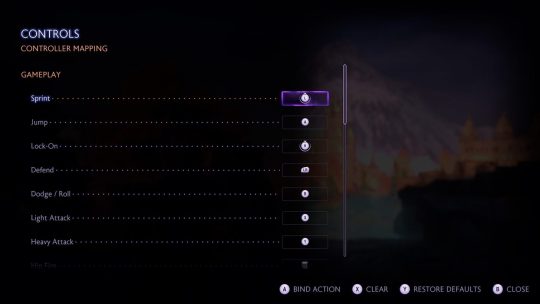
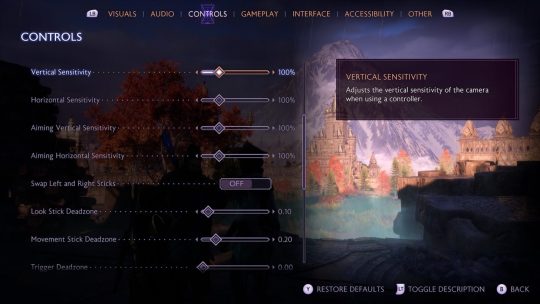
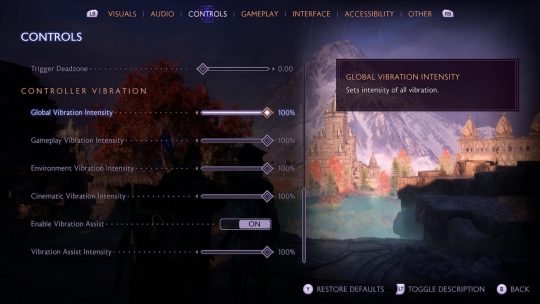
"Button Holds - Disable UI Hold Inputs can be set to Hold or Tap. When Tap is selected, various UI interactions that require an input be held for a set period of time can be activated with a single tap instead. Does not apply to gameplay actions. - Ability Wheel Controller Activation Type can be set to Hold or Tap. When set to Tap, the ability wheel will remain on screen without requiring any persistent input. - Blocking and Aiming require sustained holds. Aiming without holds is possible if the persistent dot is enabled, which can be used as an alternative to the aim-down-sights reticle."
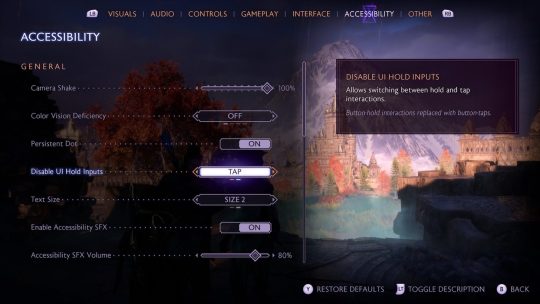
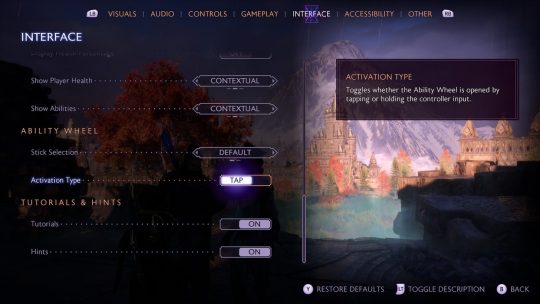
"Combat & Gameplay Controls - No QTES (quick time events) are present by design. - Rapid input sequences are present for certain attack combos during melee combat, if used. - Simultaneous inputs are present for ultimate ability, or if using the ability shortcut menu. - Quick and precise timing is not required for progression. Finisher moves, which are optional and hasten the end of combat, may require faster reactions. - Combat Assists are available in the Combat Presets to further simplify inputs during combat. Includes Aim Assist, Aim Snap, Combat Timing, and more."
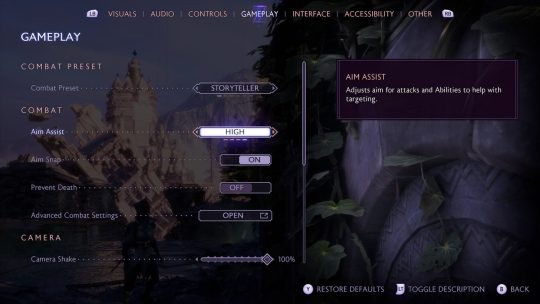
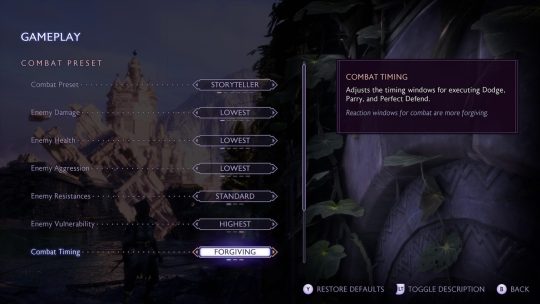
"GAMEPLAY Combat Customization Choose between presets of Storyteller, Keeper, Adventure, Underdog, Nightmare, or Custom: - Aim Assist can be set to Off, Low, Medium, and High. - Aim Snap can be turned On/Off to snap to targets. - Prevent Death can be turned On/Off. Available only in the Storyteller preset. - Enemy Damage has five options to adjust the strength of incoming attacks. - Enemy Health has five options to adjust the amount for enemy health. - Enemy Aggression has five options to adjust how aggressive enemies are during combat by changing how often they attack and how difficult they are to stagger. - Enemy Resistances has three options to adjust how much enemies can resist incoming damage. This will not affect the natural resistances some enemies have based on their faction though. - Enemy Vulnerability has three options to adjust how weak enemies are to incoming damage. This will not affect the natural weaknesses some enemies have based on their faction though. - Combat Timing has three options to adjust the timing windows for executing Dodge, Parry, and Perfect Defend actions."
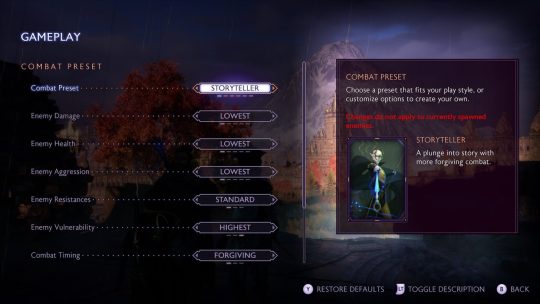
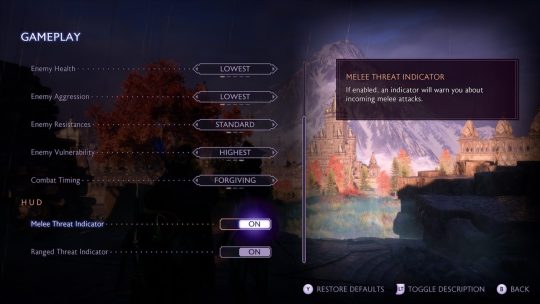
"Exploration Customization Choose between presets of No Assists, Pulse Only, Standard, Directed, or Custom: - Object Glint Visibility can be set to Off, Pulse (Short), Pulse (Long), Always to change the visibility of the glint highlight on interactable objects. - Object Glint Distance can be set to Close, Standard, and Far to change the distance of where glint highlights on interactive objects will appear. - Objective Marker Visibility can be set to Off, Pulse (Short), Pulse (Long), and Always to change the visibility of objective markers. - Waypoint Visibility can be turned On/Off to toggle the visibility of navigation waypoints leading to your quest objective."

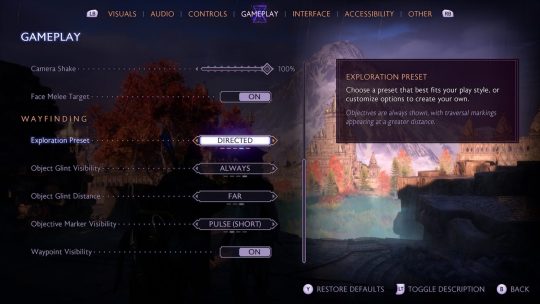
"Guidance & Progression - A Library is available for players to access at any point to help recall information. Here, players can browse the Codex to review stories and information discovered during progression, re-read letters from companions and others within the Missives, and reference the Glossary for explanations of terminology specific to Dragon Age Lore. - Tutorials teach gameplay mechanics as new inputs, skills, or actions surface. - World and Local Maps are available for wayfinding and can be referenced at any point. - Waypoint Visibility can be turned On/Off to help with progression. - Objective Marker Visibility can be adjusted between Off, Pulse (Short), Pulse (Long), and Always. - Pausable gameplay is available by design. - Saving is robust, where auto–save is frequent and players can manually save any time outside of combat, cinematics, and dialogue cutscenes."
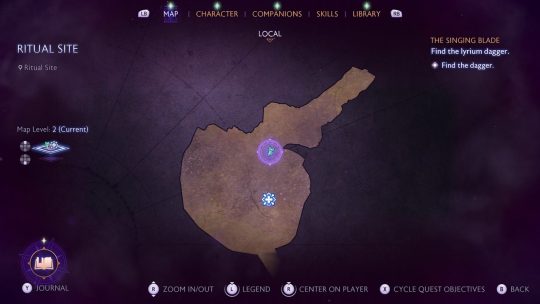
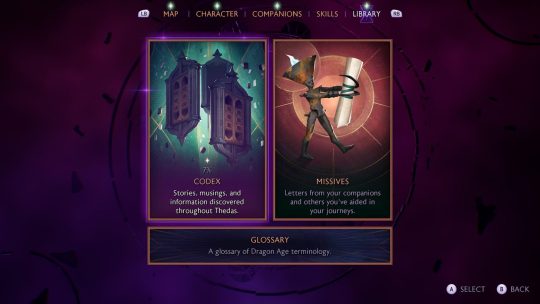
"Additional Information For more information about the game, patch notes, and news, visit the official website. Please note that this information is based on the US, English version for PC and consoles."
[source]
#dragon age: the veilguard#dragon age: the veilguard spoilers#dragon age: dreadwolf#dragon age 4#the dread wolf rises#da4#dragon age#bioware#video games#long post#longpost#solas
104 notes
·
View notes
Text

Photo by Arnold Newman.
“[W]e built a little studio at home to save the drive up and down the M4. And the studio is really very nice — little plug for Eddie Veale of Audiotech because he did a fantastic job and it sounds really nice. You know, because most home studios have a lot of trouble, you know. And it’s not really practical in some cases for people to have a home studio.” - George Harrison, Capital Radio, 1974 “Of all the former ‘Fabs,’ to use his customary term, George Harrison has remained the greatest creative homebody. […] George has rolled out of bed and returned again and again to Friar Park Studios, Henley-on-Thames (or F.P.S.H.O.T., for short) to tinker, compose and do his formal recording. […] Besides 'Cloud Nine,’ George recorded the 'Dark Horse,’ '33 1/3’ and 'George Harrison’ albums in his F.P.S.H.O.T. atelier, located in what was formerly a ballroom of the house. 'The studio was installed round 1971 and there’s been a few updates, cause when I originally put the studio in it was a 16-track. In terms of the monitoring system, after all those years in the Abbey Road EMI Studios, I put in Altec speakers. My experience in Abbey Road was that whenever the Beatles worked there and we thought we had a great sound, we’d play it back on the Altecs and it sounded terrible — ordinary. So they’re very boring in a way — and this must sound strange — but they’re also accurate! See, the Altecs don’t flatter the sound; it’s not easy to get good bass and drum sounds with them. But when I built my studio I didn’t want hype. I wanted what I’m hearing to be what it is. That way, when you play it back anyplace else it sounds fantastic! […] I’ve since made F.P.S.H.O.T. into a 24-track board. […] I’m going to get a few different choice modules made soon, but I don’t really want to go for a brand new SSL board and all that. Automation is nice in some respects, but I got my first skills at Abbey Road, so I prefer the old components, and spending a friendly weekend getting the manual mix you want. Just as I much prefer my ancient Fender Strat.’” - Musician, November 1987 (x)
#George Harrison#quote#quotes by George#quotes about George#FPSHOT#Friar Park#1970s#Harrison songwriting#Harrisongs#fits queue like a glove
60 notes
·
View notes
Text
SUMMARY During normal operation or in Safe mode, your computer may play "Fur Elise" or "It's a Small, Small World" seemingly at random. This is an indication sent to the PC speaker from the computer's BIOS that the CPU fan is failing or has failed, or that the power supply voltages have drifted out of tolerance. This is a design feature of a detection circuit and system BIOSes developed by Award/Unicore from 1997 on. MORE INFORMATION Although these symptoms may appear to be virus-like, they are the result of an electronic hardware monitoring component of the motherboard and BIOS
Dell BIOS plays classical music as a failure mode.
44 notes
·
View notes
Text
I know that whatever component is directing Mic’s voice through to his speaker is probably not just any old microphone, but I do think it would be incredibly funny if he had to remember to switch the speaker off when he was going to be near another sound system to avoid acoustic feedback
#i’ve heard people say that the directional speaker might not even be like. electrical bc of the whole quirks vs conversion thing#but i just think it would be amusing if he walked too close to another mic and you just heard that weird ringing/screeching and he was like#oh my bad#or like the weird staticky rumble it does and he just takes like several exaggerated steps away#yamada hizashi#liza blather#posts i fear reveal i have no idea how microphones work#q
47 notes
·
View notes
Text
Introducing the M-V Headgear Technology System.
A Federation workers' muzzle and visor concept/headcanon (featuring Fred).
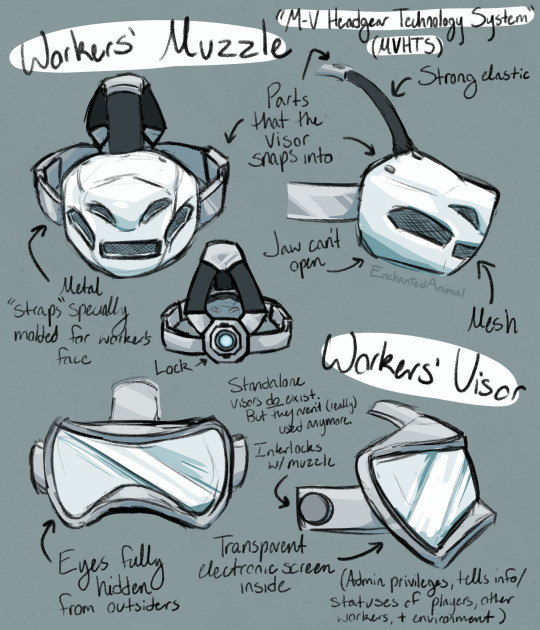

More information can be found within the following document.
A Federation Handguide to the M-V Headgear Technology System (MVHTS)
The "M-V Headgear Technology System" is made up of two main components: "Muzzles" and "Visors".
Muzzles were implemented as a safety measure. Due to incidents in the past, muzzles started to be used to prevent cases of biting. Some more common cases involved circumstances of a sudden "Polar Bear Syndrome" instance or an agitated worker. Since muzzles were introduced, cases rapidly declined and ceased to exist, and thus it became the standard and requirement for all federation workers to wear them in their daily lives to prevent any future incidents or casualties.
Visors are important in assisting workers. A transparent electronic screen on the inside allows for an overlay to be applied in real time of what they see. This allows the user to get general identifying information, statuses, and Federation notes such as warrants or warnings when looking at residents, coworkers, threats, enemies, or the environment. This also helps with training new members, as the screen shows names of individuals as well as tasks. Physically, a thick uv resistent lens provides protection from hazards, stray particles, and the sun.
When muzzles are used in combination to the visor, this allows an additional barrier of separation between the workers and the residents. Both equipment hides any indication of emotional expression by the user and prevents unnecessary relations with others, especially island residents. This is intended for physical, emotional, and mental protection of employees, as well as keeping professionalism.
Removing the M-V Headgear Technology System
If the headgear needs to be taken off, employees can enter a break room. Upon entering, a sensor in the doorway allows the locking mechanism in the back to be unlocked. The lock can then be opened, and the headgear can be removed. An attempt to leave without the gear fassened or locked will alert a superior.
Note: in recent events of employing residents (such as W0039 or "Foolish"), all workers should be more cautious of their surroundings before removing their MVHTS, even if in a break room. It's recommended that no headgear should be removed if any resident is within the building or area.
In case of emergency without easy access to a break room, users should squeeze both top and bottom buttons located on the back lock in unison for a few seconds, allowing the straps be unlocked and the device to be removed. However this method should ONLY be used in absolute emergencies. When unlocked, the headset itself will make a loud beeping noise and notify a superior.
Employees seen without their M-V headgear outside of a break room that do not have the proper clearance should be reported immediately. It should also be reported if a resident sees an employee without their headgear. Attempts to avoid being around residents while not wearing a visor, especially a muzzle, should be made at all costs as it is strictly against the rules.
While these components are highly sturdy, should any of them become heavily damaged, you should notify your nearest supervisor immediately. A temporary backup should be provided as soon as possible.
Other MVHTS Details
- In regards to WA01, aka the Census Bureau, or "Cucurucho", their muzzle is different from the others due to it's modification. A voice mod and speakers are built into it, allowing for communication with residents and fellow workers. It's also fitted with a smile design (":]") to appear more friendly and recognizable when speaking to residents. Cucurucho is the only worker to not have a visor. Do not make any reference to the appearance of their eyes in front of them.
- The only other speaking worker currently around, WS01 or "Elena", also has a muzzle fitted with a speaker and voice mod. However unlike him, she does wear a visor.
- All muzzle and visor designs are usually very fairly to each other, but as they are specially made, some are different shapes mostly depending on the form of the users face. However requests for sharper/rounder headgear are considered and can be made.
- All M-V systems of Federation workers are primarily white/light grey.
- Only the front-most "mouth" mesh is flexible enough for a straw or liquid to permiate it, allowing for drinks on the job.
- Mesh designs can vary, especially depending on the rank of the employee.
- Each lock on the back is fitted with a dim light. The color of the light differs depending on the employee/rank. For example, WC construction workers have primarily orange or yellow lights, WB workers assigned to guarding and authority have white lights, and WA workers, such as WA02, have a blue light. The higher the rank, the more likely that they may have a more unique color. Elena has a pink light and Cucurucho is an exception as they do not have a light on theirs. Lights are never red as that is reserved for indicating that the headset is unlocked or unfastened. If any workers' lights not amitting light, they should be advised immediately or be reported to a supervisor.
#qsmp#qsmp fanart#qsmp federation#qsmp fred#qsmp headcanons#qsmp hcs#mcyt#mcyt fanart#qsmp cucurucho
154 notes
·
View notes